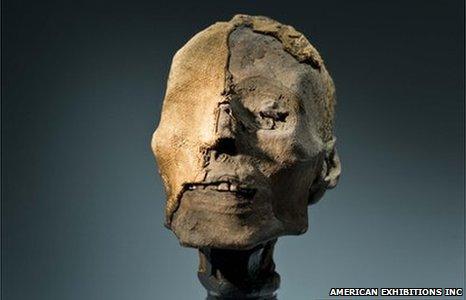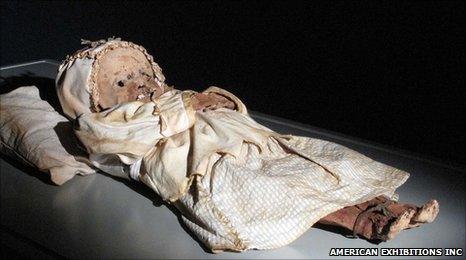'Mummies of the World' on display
- Published
The largest exhibition ever assembled of mummies has opened in Los Angeles.
Mummies of the World features a never-before-seen collection of 150 human and animal mummies and related artifacts from five continents.
As well as displaying the mummies, which have been donated by museums in Europe, the exhibition highlights the work done using modern scientific techniques to date and analyse the human and animal remains.

The museum is showcasing technology that allows scientists to analyse mummies
"We showcase the current methodology using CT scans, MRIs, X-rays, other types of techniques that allow a scientist to investigate mummies without damaging them and finding out new things about past environments, people and civilizations," says Dr Diane Perlov, senior vice president for exhibits at the California Science Centre.
The concept of the exhibition started in Germany in 2004, with the re-discovery of 20 specimens within the Reiss-Engelhorn Museums of Mannheim.
The project grew when 21 museums around Europe agreed to loan specimens for the collection.
"As a condition of the loan, they're all going be analysed, which is wonderful," says Dr Perlov.
Before being returned to their home museums, the mummies will all be examined using DNA analysis, radiocarbon dating, mass spectrometry and other techniques.
Last week one of the specimens, the remains of Michael Orlovits, who was born in 1765 and was discovered in a church crypt in Hungary, in 1994, had a CT scan at the well-known Cedars Sinai medical centre in Los Angeles.
The hospital donated its experts and equipment for the project. The mummy was among a group of specimens preserved by the cool, dry air of the crypt and the oil from the pine boards used to build their coffins.
Using DNA analysis, researchers discovered that Michael's wife, who was also in the crypt, had suffered from severe tuberculosis.
Information gleaned from present day scientific analysis of mummies is also assisting medical research.
"Mummies are not just pieces of the past - they're actually an insight into the future as well," explains Dr Heather Gill-Frerking, the scientific research curator for the German Mummy Project.
"By studying things like the DNA, by studying the development of disease, by studying the progress of movement within populations, we get a sense of where we're going in the future, not just where we've been."

Other ancient artefacts from five continents are on display
In particular, the researchers hope to shed light on the complex history of tuberculosis through the analysis of mummies.
"We're able to explore tuberculosis in several ancient populations, and so by studying the pathogen DNA over time, we've been able to look at how the strain has developed," says Dr Gill Frerking.
Now with the resurgence of tuberculosis and drug resistant tuberculosis in modern populations, we can trace the evolution of the disease and perhaps find better ways to treat it."
Other mummies in the collection include:
The Detmold Child - a preserved Peruvian child mummy, radiocarbon dated to 4504-4457BC - about 3,000 years before the birth of King Tut.
Baron von Holz - a 17th century nobleman believed to have died in or near Sommersdorf, Germany, during the Thirty Years' War (1618-48), who was discovered in the family crypt of a 14th century castle still wearing his boots.
An Egyptian cat mummy wrapped in painted linen bandaging, which dates to the Ptolemaic period (from 323- 30BC) and shows how Egyptian cats were sometimes intentionally preserved to accompany royals into the afterlife.
'Into the afterlife'
Mummification is a rare phenomenon, since it requires the preservation of soft tissue, such as skin, muscle or organs.
Naturally occurring mummies are found in bogs, ice or desert environments. Some cultures deliberately mummify bodies for long term preservation.
"The ancient Egyptians had a very strong belief about the afterlife and making sure that the body was intact going into the afterlife," says Dr Gill Frerking.
"The South Americans were very much ancestor worshippers so in some cultures it was important to keep family members intact for either discussion and decision-making or perhaps being part of family feast days.

The exhibition will run in Los Angeles for five months before embarking on a three-year, seven-city tour of the US.
"Mummies have fascinated people for a long time," says Dr Perlov.
"There is something about why is it that these mummies have survived and not decomposed. Also, the fact that they're human, we kind of see ourselves in them."